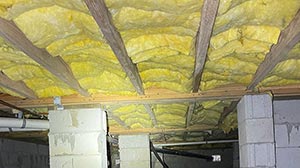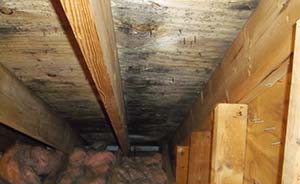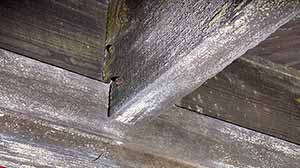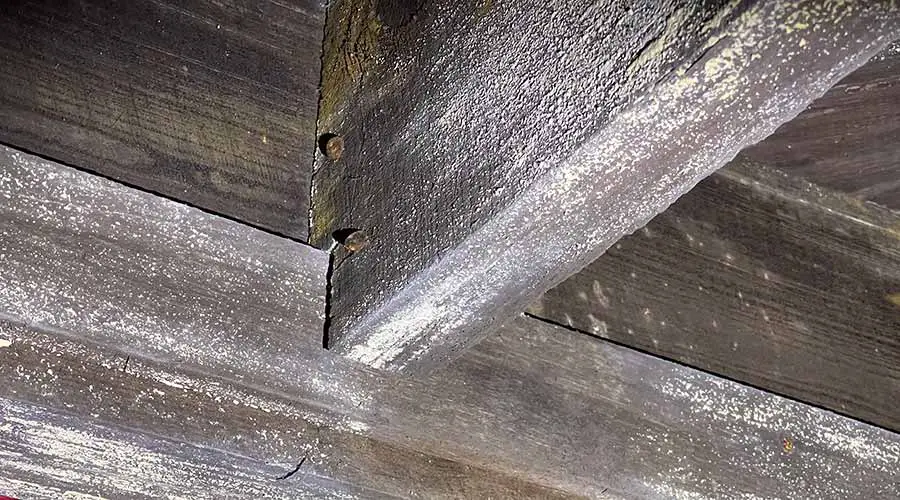
When your home starts to become older and older, you will find that your crawl space starts to develop many new and unfortunate problems. One of the most significant issues that owners face with their crawl spaces is the mold that starts growing throughout the crawl space and causing issues.
The quickest way to clean mold from your crawl space is to use bleach or white vinegar, combined with brushes and other abrasive materials. Closing off the crawl space and then scrubbing the locations with mold growing on them while wearing masks and gloves to protect you.
We always recommend that people understand the deeper facets of mold in their crawl spaces before simply going in with a brush and going crazy. Several chemicals will kill mold, several locations in the crawl space that needs to be cleaned, and many precautions that you must take.
What Chemicals and Tools will Clean Mold in a Crawl Space?
We have seen several genuinely confused people about what chemicals and tools will work the best to clean mold from a crawl space. Before we go through the exact steps needed to clean your crawl space of all mold thoroughly, we need to look at the exact tools you will need.
We always recommend that people have these at hand before entering the crawl space, as it can be a bother to go in only to find you are missing a tool. We have seen several people be surprised just how strong the normal chemicals found around the home are.
- Bleach: The most effective household item that you can use to fight any type of mold will always be bleach. As a chemical, bleach is one of the most dangerous things you can have in your home and will be effective in killing any mold that may be growing or even spreading.
- Ammonia: Ammonia has the same effect as bleach on mold, killing it instantly, but will usually work better on surfaces where bleach may be absorbed. We recommend never using the two together, choosing to use only one chemical each time when you enter the crawl space.
- Hydrogen Peroxide: When both bleach and ammonia are just simply failing their job, we recommend that you use hydrogen peroxide. This is an acid and will kill everything it touches, including your hands, and cause rust on anything metal, but it will completely eradicate all types of mold.
- White Vinegar: We recommend using white vinegar in conjunction with some of the other chemicals, using it near places that are closed to bedrooms. White vinegar kills most mold but will not cause irritation to those with weak lungs or sensitive skin as it is not a harsh chemical.
- Brushes: The chemicals will kill the mold, but they will not magically have the mold disappear into thin air; you will need to scrub the worst locations. We recommend having a soft-bristled brush for plastics and metals while using a metal scouring brush for everything else.
- Scrubbers: Some parts will not be as easy to clean with a brush; in these spots, we recommend using a scouring pad, sponges, or anything else that can be abrasive. This will clean the mold off the worst spots and help you to gather to worst of everything.
- UV Light: An addition to your home that will most likely cause you some confusion at first, a UV light kills most organic plant matter when it is still young. This includes mold, with the UV light in the crawl space killing and preventing mold from spreading further through the structure.
- Protective Equipment: You must wear the right protective equipment whenever you are cleaning mold from any location in your home. The chemicals are dangerous, and the spores released by the mold are dangerous; gloves, masks, and goggles are the only way you can be completely safe.
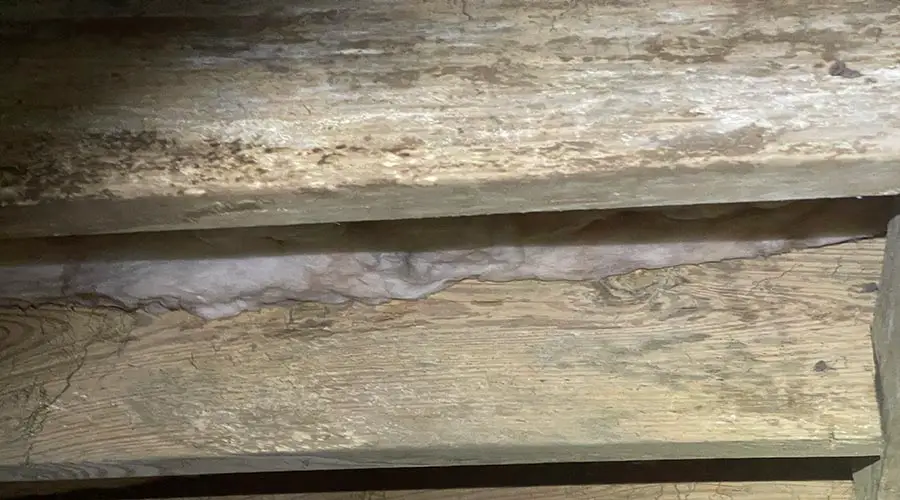
Steps to Cleaning Mold from a Crawl Space?
Now that we have your chemicals and equipment ready to go, we need to go into the crawl space to start cleaning it. We already covered in other articles how to access your crawl space, now we are going to start doing some work in the small space that runs under your house.
The steps to cleaning mold in a crawl space are similar to cleaning mold in most other places of your home, with the difference being you want to do it properly only once. If you need to clean the crawl space yearly because of mold problems, you are either not doing it correctly or have larger problems.
Suppose mold is constantly returning in the crawl space. In that case, you should consider crawl space encapsulation which includes sealing the crawl space and installing a commercial-grade dehumidifier to keep the crawl space dry.
Protective Clothing First
Before entering your crawl space, you need to have all the proper protective clothing; this includes the mask, goggles, gloves, and preferably a full bodysuit. These will protect you from the mold in the crawl space and the dust, feces, and often dead animals in the crawl space.
We have seen many people that play it brave and enter their crawl spaces with almost no protection, usually insisting that it’s for codes or regulations. However, you can get cancer, skin rashes, infections, respiratory problems, and many other diseases when entering the first few feet of a crawl space.
Read Instructions
If you are using chemicals or specialized cleaning solutions, you will need to read the instructions before heading into the crawl space. We have seen and talked to many people that have gone into their crawl spaces only to have to exit again because they needed to seal that space.
We recommend doing this at all times anyway. Still, many of the more potent purpose-built chemicals that will kill mold needs to be sealed into the crawl space, which means that you cannot simply go in and spray the chemicals everywhere, hoping that the chemicals will not affect anyone inside the home.
Cover Openings
Your crawl space has many openings that connect to the deeper parts of your home, and you will need to close all of these. Further, checking the ventilation pipes and everything else for leaks will also be necessary; the last thing you want is bleach fumes going through the HVAC system.
Having every possible hole or vent sealed will ensure that your crawl space cleaning trip does not change into a situation of gassing everyone. Further, as you are cleaning, mold spores can travel through the vents into your home, becoming much worse problems you need to solve.
Brushes, Scrubbers, and Abrasive Material
Once everything has been sealed, and you have read the instructions on the chemicals, it is time to start cleaning everything. Scrub the foundation walls with plastic brushes, flat metals with sponges and cloths, plastics with soft brushes, and every other hard surface with the hardest brushes.
Choosing which brushes work the best for your crawl space will require a judgment call from you as everyone has different types of crawl spaces. People often prefer to use one plastic brush throughout the crawl space to get everything clean.
Cover the Ground with a Vapor Barrier
As you finish up, we know there will be a place where you are not even thinking of keeping clean or scrubbing. To scrub every surface, you’ll need to cover the ground with a vapor barrier.
People often forget to do this, and as the winds blow and the rains come falling, the mold spores in the sand of the crawl space are disturbed. Creating new mold spores that take root and quickly overtake every spot you have already cleaned properly.
A vapor barrier helps to keep the wood from absorbing ground moisture. Mold can’t flourish. Mold needs moisture to grow, so aim to keep your wood moisture content at 18% or below. Ideally, you should aim for 14% or less.
Use a moisture meter to check the wood moisture content. A good moisture meter that won’t damage your floor joists is the Klein Tools Pinless Moisture Meter available at Amazon.
UV Lamp if Possible
If you have a set of UV lamps, you need to set them up as you finish packing everything up and closing the crawl space. We always recommend leaving the UV light in the crawl space for a few hours or a full 24 hours; they will kill any of the mold spores that you missed.
UV lights mimic the sun, and mold cannot live when the UV rays hit them, with most crawl spaces never seeing the light of day. You will have to be careful; some larger UV light will also heat up and become extremely hot, making them dangerous to keep in your crawl space for too long.
Leave to Dry
After scrubbing everything and removing the UV lights, it is time to leave everything to dry out completely. Moisture is the main reason that your crawl space will suddenly have mold growing throughout it, which is why keeping it as dry as possible is essential.
If you have a dehumidifier, you can place it inside the crawl space for a short while to ensure no pockets of moisture hiding away. However, if you have timed everything to happen in the dead of Summer, then the heat may be enough to dry out the crawl space completely.
Will Bleach Kill Mold in Crawl Space?
Yes, bleach will kill mold in a crawl space, and it will also kill almost everything else that is causing a problem. Bleach is almost pure chlorine with only a few other things mixed in, and organic life cannot survive in this mixture of chemicals, which is why people often use bleach to disinfect items.
You can use bleach to kill almost all types of mold on any surface throughout your home, with many people using bleach to control the mold in their bathrooms. We recommend doing this as well as it will keep your shower and toilets as clean as they can be without resorting to more dangerous chemicals.
It is vital to understand that bleach is one of the strongest chemicals you can use, but it is not the strongest. When going to hardware stores or specialist chemical providers, you can often find dangerous chemicals to handle without gloves but completely eradicate all mold within seconds.
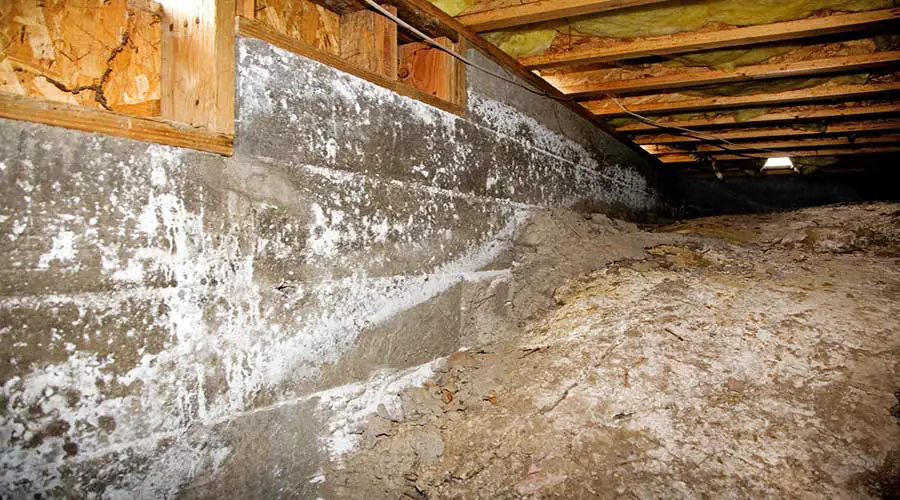
What Happens if You Have Mold in Your Crawl Space?
Before we start hearing people tell us that mold is natural and should be left alone, there are many structural damages that mold can cause. Not least of which is physically growing into gaps and starting to separate boards, sometimes helping to loosen nails.
However, the immediate danger from mold will always be the health risks that come with them, as they are often deadly to those who breathe them in. Mold needs to be stopped and controlled before it can become a danger to everyone living in the home where the crawl space is.
- Eye Irritation: The first thing that many people start noticing when their crawl space is filled with mold is suddenly having eye irritation. This can be when the wind moving through your house bothers you or when you are turning on the AC and suddenly need to blink a million times.
- Respiratory Problems: The most dangerous problem from mold is the respiratory problems that they will start to cause. You will usually find that you are having trouble breathing or that your family members are constantly getting sick or showing some symptoms.
- Coughing: The surest sign that mold is growing is when everyone in your family suddenly starts to develop a cough. Usually, people will ignore this sign as they assume everyone has gotten a cold, but it is usually a sign that mold is growing.
- Wheezing: Often mistaken for people with asthma having asthma, constant wheezing of your lungs will be caused by mold spores entering your lungs. If you suddenly develop one, it is always a good sign that your crawl space has been infected with many molds.
- Skin Irritation: This is one of the more overlooked symptoms caused by mold growing inside your crawl space. Your skin can suddenly always be itchy, or you can develop a rash where the spores are concentrated, either way, it will feel like your skin has become a giant rash.
- Infection: If you have small wounds, or your lungs are weak, or perhaps you have a baby, infections will often be created or worsened by mold. You must ensure that your crawl space has no mold, especially when someone is sick or injured, to prevent damage.
Conclusion
Cleaning mold from your crawl space involves getting the right chemicals, the right amount of brushes, and using some elbow grease to clean everything. However, preventing molds from forming in the first place is even more crucial.


